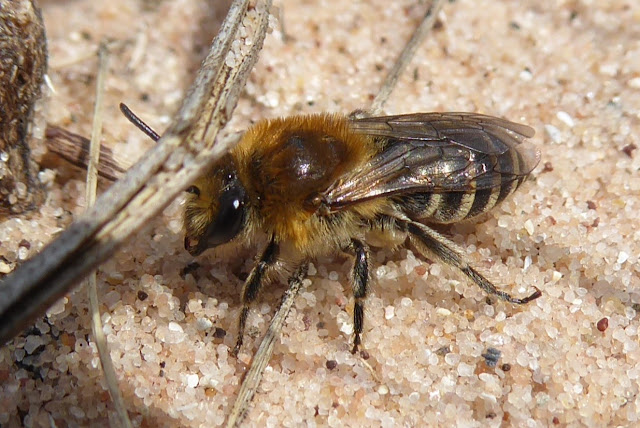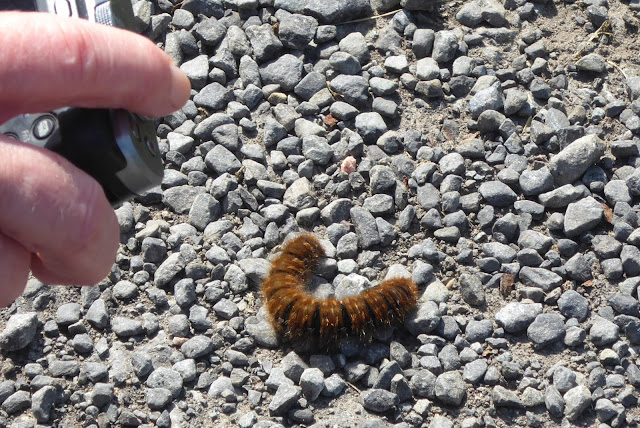This weekend saw the second of two trips this Summer by the Orkney Field Club to the island of Hoy in search of dragonflies and hairy caterpillars. The weather was much kinder to us than a month ago, with plenty of sunshine and a pleasant breeze, which kept the midges at bay.
Speaking of bays, here's where we began the walk after a boat journey from Stromness and the community bus from Moaness to Rackwick.
 |
| Rackwick Bay, Hoy |
From the car park, we walked along the back of the dunes, finding Fox Moth caterpillars, my first ever (although they're common enough) Shaded Broad-bar moth and a new site for Six-spotted Burnet moths (indeed only the second site for the county).
 |
| Shaded Broad-bar moth |
 |
| A Red Ant on a Grass of Parnassus flower |
 |
| Six-spotted Burnet moth |
 |
| Fox Moth caterpillar |
After second breakfast (or first lunch), our intrepid group wandered into the dunes where we found dozens of
 |
We then set off along the tarmac road to a couple of water bodies known locally as the Toady Pools, finding more caterpillars along the way.
 |
| Northern Eggar caterpillar, which had to relocated from the road due to imminent vehicular traffic |
 |
| Emperor Moth caterpillar |
Just before reaching the Toady Pools, whilst investigating a sand bank for more mining bees, I spotted what looked like a dung beetle on some sheep droppings. Closer inspection showed it to be the elytra (hardened forewings) of a much larger beetle attached to the remnants of a bird pellet (also containing many other beetle parts). As luck would have it, our wee band contained the county beetle recorder BR (yes, really), who happily accepted the 'gift', and revealed its identity. Let me just be clear here, not only was the beetle no longer alive, it wasn't even recently dead. It had been eaten by a bird, digested and then had its hard parts regurgitated as a pellet. Now, I call that an impressive piece of IDing! The icing on the cake was when BR admitted that he had never seen a live one, just the odd dead one (they're quite difficult to find in Orkney), but it was instantly recognisable as of the four species of large carabid beetle in the county, this species has smooth elytra which are fused together.
However, poor marks for me as I neither took a photo nor remembered the name of the beetle. Hopefully, it will be mentioned in this year's beetle report. Later edit: the species now confirmed as Carabus glabratus by BR.
After all that excitement, we eventually made it to the Toady pools where there were plenty of Common Blue Damselflies and Emerald Damselflies engaged in courtship, mating and egg-laying. With their respective species partners, not some weird cross-species shenanigans. Same for Black Darter dragonflies though fewer in number.
 |
| A male Emerald Damselfly |
We now began the trek over the Old Post Road, a rough track through heather moorland, over a saddle between the archipelago's two highest hills, which would take us back to Moaness. Whilst the path was still at low level by a burn, we saw some Common Hawker dragonflies, a few Heath Bumblebees and parasitic wasp which seemed to be intent upon laying an egg in a sawfly larva. The larva wasn't exactly overjoyed at the thought of this, and was busy thrashing around its rear end to put off the wasp.
As we neared the pier at Moaness, somewhat coincidentally, there was just enough time to pop into the local cafe for refreshments and a sit down.
It was a great day, with some wonderful wildlife, and shared with a companionable group who all contributed to finding and IDing things. Thank you, everyone.



Your camera captured the Emerald well, not much to focus on with such a slender body!!!
ReplyDeleteThank you! I didn't take too many photos as I was co-leading the walk and needed to concentrate on not losing anyone 😎
DeleteMark, also, we met a couple who were up in Orkney working on the KH!
Delete